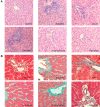1,25(OH)2D3 downregulates the Toll-like receptor 4-mediated inflammatory pathway and ameliorates liver injury in diabetic rats
- PMID: 25906757
- PMCID: PMC4768236
- DOI: 10.1007/s40618-015-0287-6
1,25(OH)2D3 downregulates the Toll-like receptor 4-mediated inflammatory pathway and ameliorates liver injury in diabetic rats
Abstract
Background: Fatty acid deposition in the liver can activate a number of pro-inflammatory signaling pathways such as the Toll-like receptor 4 (TLR4) pathway, which may be important in the pathogenesis of nonalcoholic steatohepatitis. 1,25(OH)2D3 downregulates the expression of TLR4 and may represent a novel treatment strategy for reducing hepatocyte injury. Therefore, in this study, we investigated the protective effects of 1,25(OH)2D3 on diabetic liver injury in vivo.
Methods: Streptozotocin (STZ)-induced diabetic rats were randomly divided into five groups and treated with low-dose 1,25(OH)2D3 (0.025 μg/kg/day), medium-dose 1,25(OH)2D3 (0.15 μg/kg/day), high-dose 1,25(OH)2D3 (0.3 μg/kg/day), insulin (protamine zinc insulin 16 U/kg/day, subcutaneous injection), or no intervention (the control group). Sixteen weeks later, the rats were killed, and blood samples were obtained to test lipid profiles and hepatic function. The infiltration of inflammatory cells, the level of fibrosis, and the expression levels of TLR4, nuclear factor-kappa B (NF-κB), and tumor necrosis factor-α (TNF-α) in the liver were analyzed. The hepatocytes were treated with vehicle control, LPS (100 ng), high fat [DMEM + FFA (0.1 mM: palmitic acid, oleic acid, 1:2)], LPS + high fat, vehicle + 1,25(OH)2D3 (10(-7) M), LPS + 1,25(OH)2D3, high fat + 1,25(OH)2D3, or LPS + high fat + 1,25(OH)2D3. RNA and protein were extracted to detect the expression of TLR4 and downstream inflammatory factors such as NF-ΚB, TNF-α, and IL-6. Groups of data were compared by single factor variance analysis.
Results: High-dose 1,25(OH)2D3 administration for 16 weeks downregulated the expression of TLR4, NF-κB, and TNF-α in the liver tissue of diabetic rats and attenuated hepatic inflammation and fibrosis, as shown by immunohistochemical staining, hematoxylin and eosin staining, Masson's trichrome staining, reverse transcription polymerase chain reaction (RT-PCR), and western blotting. In vitro, hepatocytes treated with high fat or LPS exhibited significantly increased expression of TLR4, NF-κB, and downstream inflammatory factors (P < 0.05). Intervention with 1,25(OH)2D3 decreased the expression of TLR4, NF-κB, and inflammatory factors (P < 0.05).
Conclusions: 1,25(OH)2D3 exhibited protective effects against diabetes-related liver injury, possibly through downregulation of components of the TLR4 signaling pathway.
Keywords: 1,25(OH)2D3; Diabetes; Hepatocytes; Inflammation; Liver injury; Toll-like receptor 4.
Figures




Similar articles
-
1,25(OH)2D3 provides protection against diabetic kidney disease by downregulating the TLR4-MyD88-NF-κB pathway.Exp Mol Pathol. 2020 Jun;114:104434. doi: 10.1016/j.yexmp.2020.104434. Epub 2020 Mar 30. Exp Mol Pathol. 2020. PMID: 32240615
-
[Inhibition of Toll-like receptor 4 pathway by TAK242 protects the liver in sepsis].Zhonghua Wei Zhong Bing Ji Jiu Yi Xue. 2022 Aug;34(8):814-818. doi: 10.3760/cma.j.cn121430-20220420-00395. Zhonghua Wei Zhong Bing Ji Jiu Yi Xue. 2022. PMID: 36177923 Chinese.
-
Effect of nuclear factor-κB and angiotensin II receptor type 1 on the pathogenesis of rat non-alcoholic fatty liver disease.World J Gastroenterol. 2015 May 21;21(19):5877-83. doi: 10.3748/wjg.v21.i19.5877. World J Gastroenterol. 2015. PMID: 26019451 Free PMC article.
-
Alleviation of non-alcoholic fatty liver disease by Huazhi Fugan Granules is associated with suppression of TLR4/NF-κB signaling pathway.Clin Investig Arterioscler. 2021 Sep-Oct;33(5):257-266. doi: 10.1016/j.arteri.2020.12.007. Epub 2021 Mar 31. Clin Investig Arterioscler. 2021. PMID: 33810882 Review. English, Spanish.
-
Ciprofloxacin and levofloxacin attenuate microglia inflammatory response via TLR4/NF-kB pathway.J Neuroinflammation. 2019 Jul 18;16(1):148. doi: 10.1186/s12974-019-1538-9. J Neuroinflammation. 2019. PMID: 31319868 Free PMC article. Review.
Cited by
-
Dietary supplementation of vitamin D prevents the development of western diet-induced metabolic, hepatic and cardiovascular abnormalities in rats.United European Gastroenterol J. 2018 Aug;6(7):1056-1064. doi: 10.1177/2050640618774140. Epub 2018 May 17. United European Gastroenterol J. 2018. PMID: 30228894 Free PMC article.
-
Leflunomide an immunomodulator with antineoplastic and antiviral potentials but drug-induced liver injury: A comprehensive review.Int Immunopharmacol. 2021 Apr;93:107398. doi: 10.1016/j.intimp.2021.107398. Epub 2021 Feb 8. Int Immunopharmacol. 2021. PMID: 33571819 Free PMC article. Review.
-
Protective Effects of Celastrol on Diabetic Liver Injury via TLR4/MyD88/NF-κB Signaling Pathway in Type 2 Diabetic Rats.J Diabetes Res. 2016;2016:2641248. doi: 10.1155/2016/2641248. Epub 2016 Jan 19. J Diabetes Res. 2016. PMID: 27057550 Free PMC article.
-
Bioinformatics analysis of hepatic gene expression profiles in type 2 diabetes mellitus.Exp Ther Med. 2019 Dec;18(6):4303-4312. doi: 10.3892/etm.2019.8092. Epub 2019 Oct 10. Exp Ther Med. 2019. PMID: 31772629 Free PMC article.
-
MicroRNAs in Anticancer Drugs Hepatotoxicity: From Pathogenic Mechanism and Early Diagnosis to Therapeutic Targeting by Natural Products.Curr Pharm Biotechnol. 2024;25(14):1791-1806. doi: 10.2174/0113892010282155231222071903. Curr Pharm Biotechnol. 2024. PMID: 38178678 Review.
References
-
- World Health Organization . Definition, diagnosis and classification of diabetes mellitus and its complications: report of a WHO Consultation. Part 1. Diagnosis and classification of diabetes mellitus. Geneva: World Health Organization; 1999.
-
- Wiedermann CJ, Kiechl S, Dunzendorfer S, Schratzberger P, Egger G, Oberhollenzer F, et al. Association of endotoxemia with carotid atherosclerosis and cardiovascular disease: prospective results from the Bruneck Study. J Am Coll Cardiol. 1999;34(7):1975–1981. doi: 10.1016/S0735-1097(99)00448-9. - DOI - PubMed
Publication types
MeSH terms
Substances
LinkOut - more resources
Full Text Sources
Other Literature Sources
Medical

